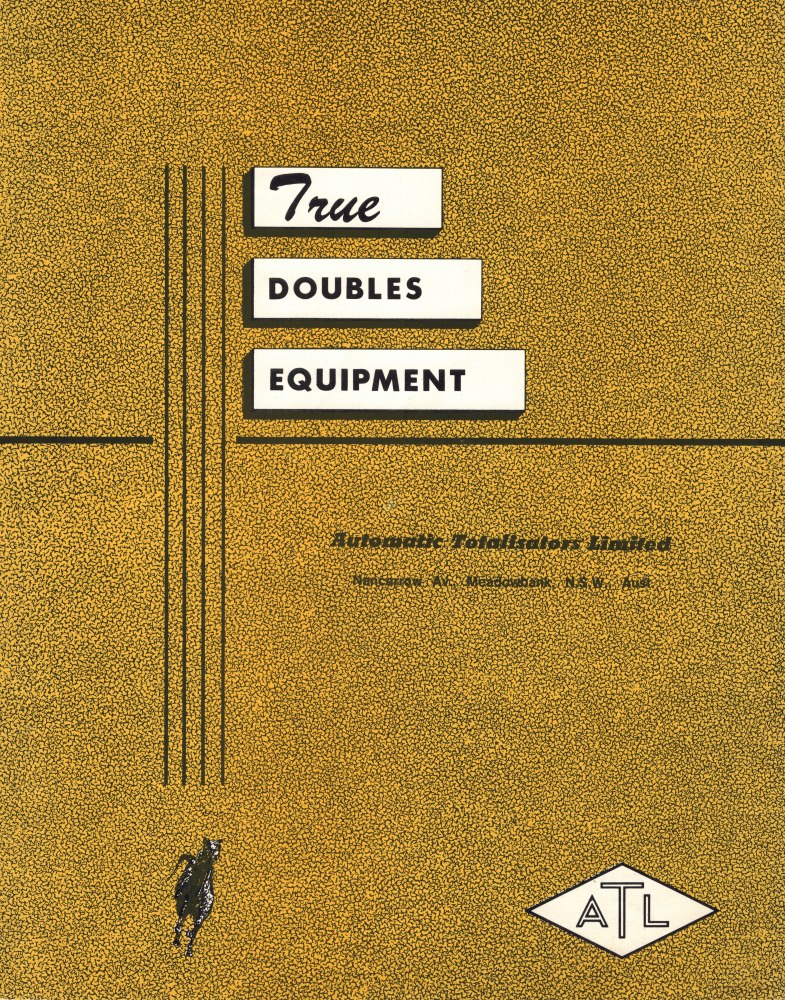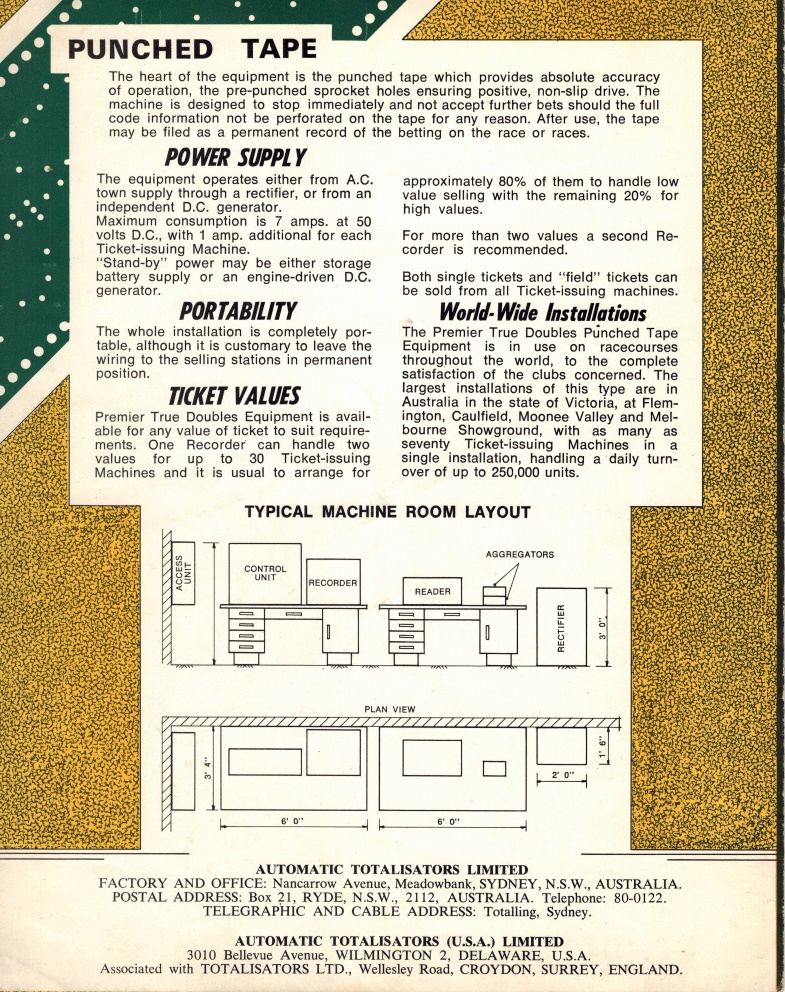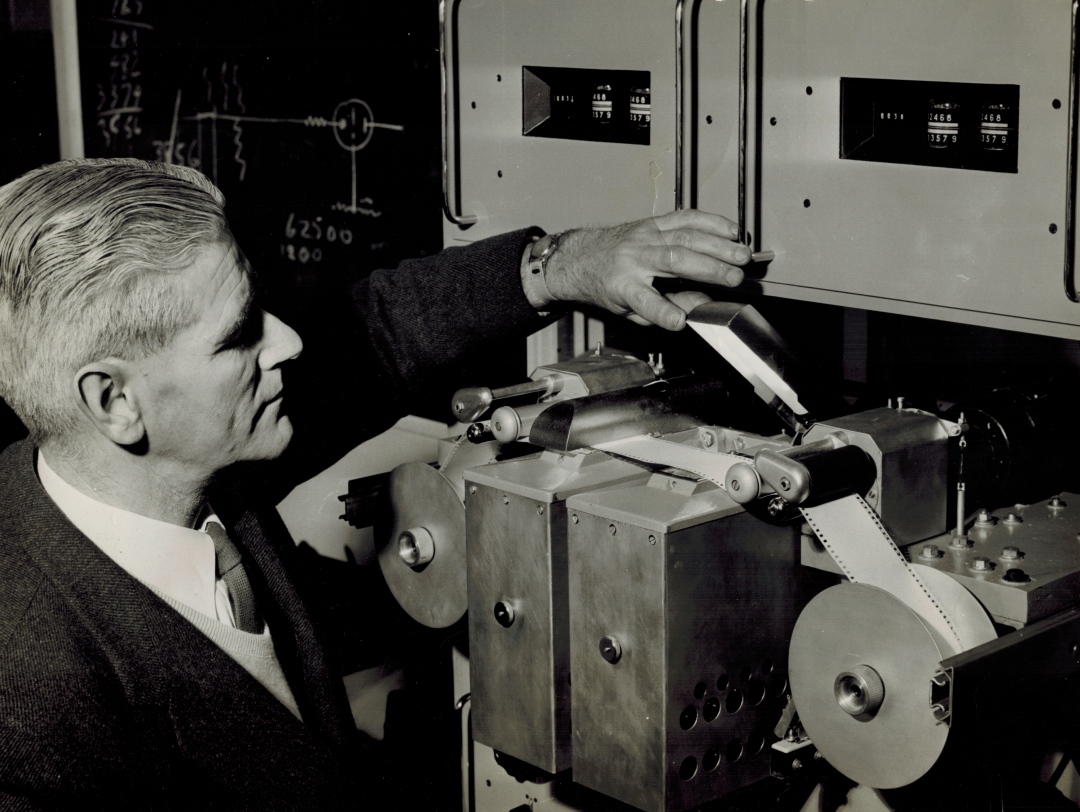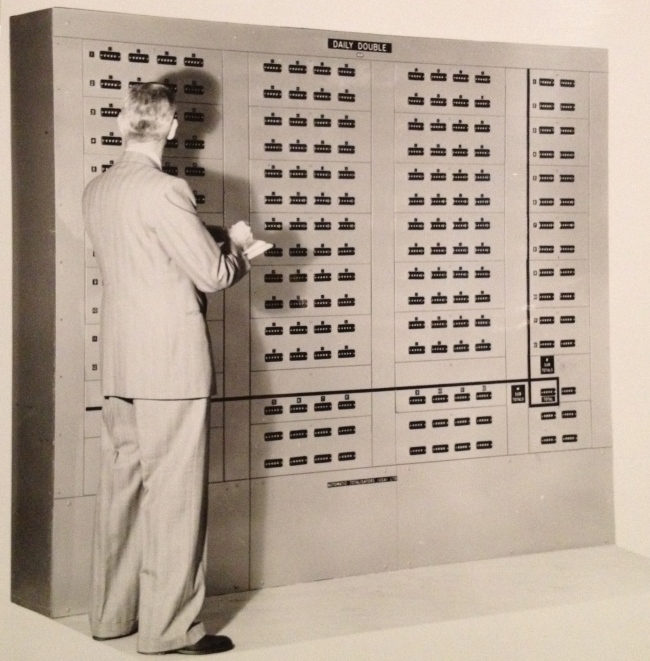This page contains a photograph which is one of several belonging to the photo gallery pages which are part of several history pages relating to the invention of the world's first automatic totalizator in 1913 and Automatic Totalisators Limited, the company founded to develop, manufacture and export these systems.
Doubles Brochure Courtesy Chris Robertson
These images show the front and back of a Doubles Pool ATL Product brochure in the form of an A4 size card. This and other cards like it on this website were provided by Chris Robertson, an ex customer of the company and an expert on its products and installations around the world. This brochure was probably produced in the 1960s.

Click on the image to go back to the photo gallery
This is the front of an Automatic Totalisators product promotion card

Click on the image to go back to the photo gallery
This is the back of an Automatic Totalisators product promotion card
Following is information provided by Neville Mitchell on the Doubles equipment that relates to the diagram in the page above under the heading TYPICAL MACHINE ROOM LAYOUT.
The ATL doubles equipment was four units, first, the Paper tape transport and punch, the second was the reader. There was usually two control cubicles. One was the race controller, containing the various relay sets, not unlike a modern TCC (Webmaster's note: TCC - Tote Control Console). From memory >> Control panel, Relay sets= 1) Control 2) Guard Relay Set 3) Routiner. Power supplies 50 and 12 volts were included in the usual doubles systems.
The second unit contained the access relay sets. Each set was for 10 X J10 TIMs. Up to 49 TIMs. One access position was for the Routiner, which provided internal self testing of the recorder and its associated paper tape punch.
The Guard Relay set was system to detect faults in the punch, it would set up an alarm if a punch solenoid failed.
The Reader had two READ HEADS, one after the other so both heads must have the same readout on their respective counters. The dials on each head were set to read the combination required. On reading the doubles tape, after the running of the first leg, multiple passes were performed. The left dial on each head was set to the winner and the right dial set to each runner in the second leg in sequence per pass and totals recorded. A last pass was done with the field selection on the right dial. In the event of a misread, the tape would be run backwards and forwards to determine a correct read.
Over many years the ATL doubles Quinella punch Tape recorder and reader did wonderful service. I do not know how many units were manufactured, there was an into stock production run of five each year.
Following is information extracted from an article by Peter Collier Titled Doubles Betting Comes to Melbourne dated 7 February 2011 which appears on Don McKenzie's website on Automatic Totalisators in Victoria.
The recording equipment was a set of electromagnets that moved a system of rods and bars that were moved under the main solenoid that when energised would then drive the selected punches through the paper tape recording the combination as a set of 4 holes (or 3 holes if the selection in 1 leg was a field bet) across the paper, 2 holes represented a runner in the first leg and 2 holes represented the runner in the second leg. When the solenoid released the paper was advanced so that it was in position for the next bet to be recorded. After the first leg of the double was run the paper tape that recorded the bets was wound through to provide a leader and then cut off, a length was then wound through and fed on to the bobbin on the recorder in readiness for recording the next race. The paper tape was then mounted on the reader and the switches set for the winner of that race and all runners in the second leg in sequence and the tape was passed over the reading head and the number of selections counted and displayed on an electronic readout. After all reading was completed it was then possible to declare odds for the second leg and the figures were available for the calculation of the dividend when the second leg winner was known.
... Each punch tape recorder was capable of supporting 32 ticket issuing machines using an access set that allowed only one ticket machine to record a bet at a time.
Webmaster's note: The following image appears in the photo album index of this website, prior to the image shown at the top of this page. The person in the image is Don Hardy. To view the full sized version of it, click on the first image on this page and scroll up to the image thumbnail with associated text starting Having mentioned Doubles equipment and click on that thumbnail.
An original Doubles Pool Papertape system

... The original paper tape readers used thermionic valves to electronically count the combinations as they were passed over the reading head which was made up of 18 photo electronic sensors with an incandescent light above the paper tape. As the paper with the holes punched in it passed over the read heads the sensors would detect the row of holes and the rest of the electronics would count the combinations that had been selected by the switches. Each reader consisted of two read heads over which the paper tape was passed and each head was independent of the other which meant each read was checked against the other head. This was what ATL called "the check on the check". Each horse was represented by 2 holes in each leg of the race (unless it was a field bet).
A Daily Double Pool Counter Tote

Neville Mitchell wrote about the above photo: This photo is of Don Hardy and the RHJC Daily Double Counter Tote. The system used J10 issuers and typical counter tote relay control units i.e., Access, Multi impulse Routiner. Other counter totes were made for RHJC as the demand for "exotic" betting grew. In 1969 I installed a ex RHJC counter tote in Sabah. RHJC mentioned by Neville is the Royal Hong Kong Jockey Club as it was known when Hong Kong was a British Colony. The issuer Neville Refers to is a TIM (Ticket Issuing Machine)
The writing on the top of this rack clearly reads DAILY DOUBLE. The writing on the bottom of the rack reads AUTOMATIC TOTALISATORS IUSA LTD. Neville Mitchell wrote about the text on the bottom: The Automatic Totalisator IUSA name plate is a bit of a mystery. I can only suggest that at that time, late 1950's, AUTUSA was being established, and it could mean INCORPORATED? There was a lot of legal problems with setting up in USA due to what was called the "Sherman Act" which prevented monopolies existing or being formed. Neville mentions ATUSA which is the original name of Automatic Totalisators' subsidiary company in the United States and was an acronym for Automatic Totalisators United States of America. The company had a later name change to Autotote.



